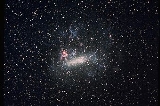
Large Magellanic Cloud
Overview
Irregular galaxy
An irregular galaxy is a galaxy that does not have a distinct regular shape, like a spiral or an elliptical galaxy. The shape of an irregular galaxy is uncommon – they do not fall into any of the regular classes of the Hubble sequence, and they are often chaotic in appearance, with neither a...
galaxy
Galaxy
A galaxy is a massive, gravitationally bound system that consists of stars and stellar remnants, an interstellar medium of gas and dust, and an important but poorly understood component tentatively dubbed dark matter. The word galaxy is derived from the Greek galaxias , literally "milky", a...
, and is a satellite
Satellite galaxy
A satellite galaxy orbits a larger galaxy due to gravitational attraction. Although a galaxy is made of a large number of objects which are not connected to each other, it has a center of mass, which represents a weighted average of the positions of each component object...
of the Milky Way
Milky Way
The Milky Way is the galaxy that contains the Solar System. This name derives from its appearance as a dim un-resolved "milky" glowing band arching across the night sky...
. At a distance of slightly less than 50 kiloparsecs (≈160,000 light-year
Light-year
A light-year, also light year or lightyear is a unit of length, equal to just under 10 trillion kilometres...
s), the LMC is the third closest galaxy to the Milky Way, with the Sagittarius Dwarf Spheroidal
Sagittarius Dwarf Elliptical Galaxy
The Sagittarius Dwarf Elliptical Galaxy is an elliptical loop-shaped satellite galaxy of the Milky Way Galaxy. It consists of four globular clusters, the main cluster being discovered in 1994...
(~ 16 kiloparsecs) and Canis Major Dwarf Galaxy
Canis Major Dwarf Galaxy
The Canis Major Dwarf Galaxy is located in the same part of the sky as the constellation Canis Major. The galaxy contains a relatively high percentage of red giant stars, and is thought to contain an estimated one billion stars in all....
(~ 12.9 kiloparsecs) lying closer to the center of the Milky Way. It has a mass equivalent to approximately 10 billion times the mass of our Sun (1010 solar mass
Solar mass
The solar mass , , is a standard unit of mass in astronomy, used to indicate the masses of other stars and galaxies...
es), making it roughly 1/100 as massive as the Milky Way, and a diameter of about 14,000 light-years.
Unanswered Questions

